Editing Checklist
This page provides a way to ensure your edition is complete.
Representing the Original
Review the documentation on this topic here.
❒ I have used <pb/> to mark the start of each new page (or each document image) and have configured the values for n and facs, as appropriate.
❒ I have used <p> to enclose all paragraphs. When paragraphs are indented in the original, I have used <p style="indent>.
❒ I have used <lb/> (or <lb break="no", when a word is divided across lines) to represent where line breaks occur in the original.
❒ If my document is a letter, I have used <opener> and <closer>, as appropriate.
❒ If my document is a letter and contains an image of the envelope, I have handled the envelope (and stamp and postmark) as explained under "6. Envelopes" on this page.
❒ I have represented headings and body text as they appear in the original to the best of my ability, as discussed in the section "Representing layout/formatting of original document" on this page.
❒ I have marked any text that is struck in the original with <del>, using values of "strikeout" or "overwritten" for the type attribute, as appropriate.
❒ I have used <add> to mark any text that was written in above the line, or otherwise inserted, using values of "caret" or "no_caret" for type, as appropriate.
❒ I have used <note type="authorial"> to mark up any notes the author (or perhaps someone else) added in the margins of the text, with a value or "marginLeft," "marginRight," "marginTop," or "marginBottom" for place.
❒ I have used <gap/> to indicate any gaps in the text, using a value for reason to explain the situation.
❒ I have used the following character references as needed:
- ° to represent the degree sign (as in 98° Fahrenheit)
- & to represent the ampersand (&)
Regularizing the Text
You can review the documentation on this topic here.
❒ I have used <choice><abbr></abbr><expan></expan></choice> to resolve abbreviations. If the a value enclosed in <abbr> has letters in superscript, I have marked those up with <hi style="superscript">, as in this example: <choice><abbr>1<hi style="superscript">st</hi></abbr><expan>first</expan></choice>.
❒ I have used <choice><sic></sic><corr></corr></choice> to document and correct misspellings or evident errors when doing so does not change the sound of the text when read aloud.
❒ I have used <choice><orig></orig><reg></reg></choice> to standardize a correct but archaic or otherwise not standard spelling, when doing so does not change the sound of the text when read aloud.
❒ I have respected the use of lower-case/upper-case letters but have made them match standard usage today in the reading version by using <choice><orig></orig><reg></reg></choice>.
❒ I have documented the punctuation that is present in the text, but have also regularized it according to standard usage today using sequences of elements such as those found in the final section on this page.
Doubts, Comments, Annotations and Additions
You can review the documentation on this topic here.
❒ I have used <unclear> to mark up words or phrases about which I have doubts, providing a value for cert to indicate the relative level of my certainty about what I've transcribed and reason to indicate why I'm uncertain.
❒ I have used XML comments in the format <!-- --> to add notes to the text that may be helpful to me or others who might have reason to open the XML file in an editor like oXygen in the future (users of the edition itself, who look at it on the web, won't see these comments).
❒ I have used <note type="transcription"> to provide explanations that might help users of my edition compare my transcription to the document image, or understand decisions I have made, when looking at the "transcription" view.
❒ I have used <note type="editorial"> to provide any interpretive annotations that I believe should be visible to users in the "reading text" view.
❒ I have used <supplied> to mark up any letters of words that I have added myself when there is a gap (such as a smudge or torn page) and I believe that there is reason to believe, from context, that these letters or words represent the missing material. I have provided values for reason to explain my thinking and cert to indicate the level of my certainty.
Encoding Semantic Aspects
You can review the documentation on this topic here.
❒ I have used <date> to mark up dates, however they are articulated, providing a value for when in the format YYYY-MM-DD, YYYY-MM or YYYY, as appropriate to the situation.
❒ I have used <name type="person"> to mark up names of individual people.
❒ I have used <name type="person_group"> to mark up the names of groups.
❒ I have used <name type="place"> to mark up the proper names of places, providing a value for subtype like those indicated on this page.
❒ I have used <name type="company"> to mark up the proper names of business entities.
❒ I have used <name type="organization"> to mark up the proper names of organizations.
❒ I have used <name type="event"> to mark up the proper name of an organized event.
❒ I have used <title level="m"> to mark up the name of a book (this will make it appear in italics in our interface).
❒ I have used <title level="a"> to mark up the name of an article or other subsection of another written text (this will make it appear within double quotation marks in our interface).
